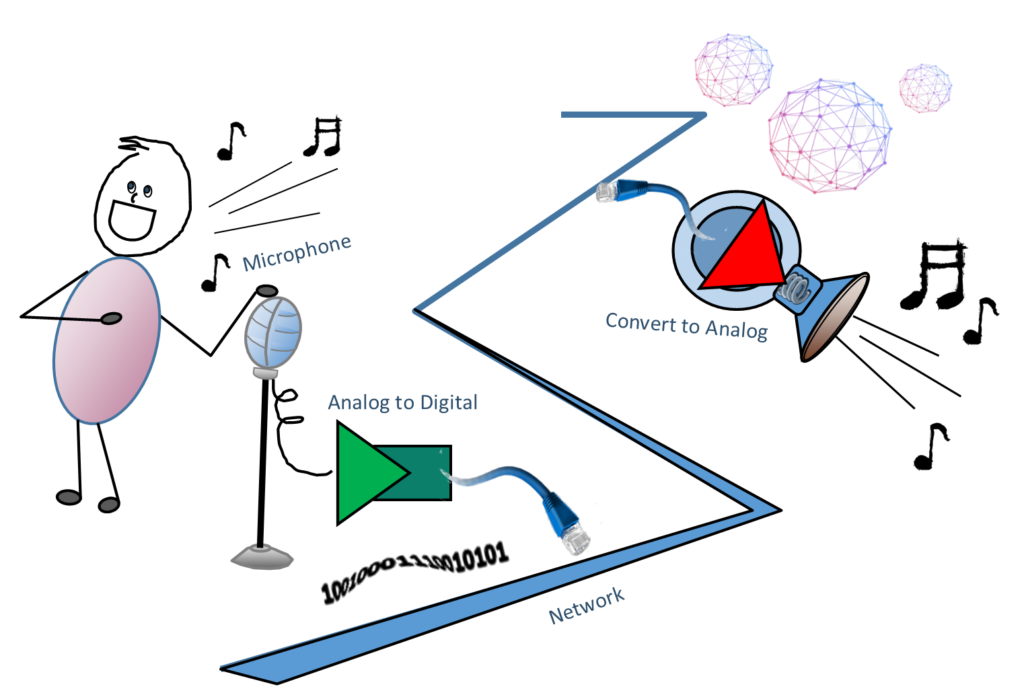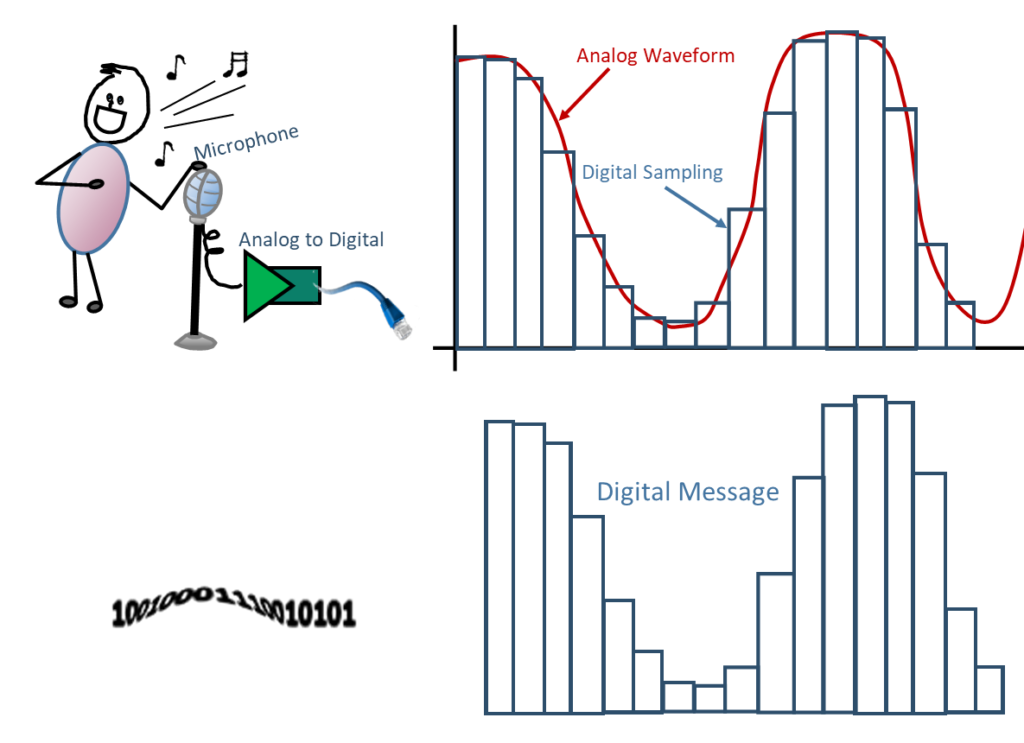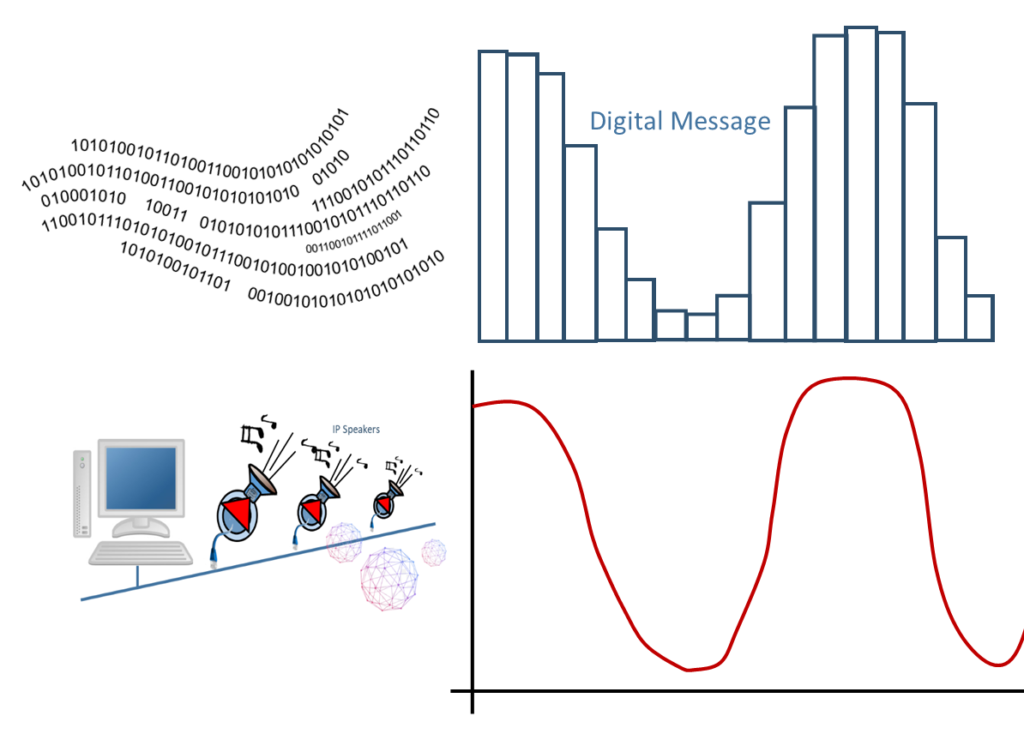Transmitting Audio Over the Network

The sound waves from someone singing are picked up by a microphone and converted to analog electric signals. This electric signal can be sent to an amplifier and then to a speaker so that many people can hear the sound. When we convert the analog signal to a digital signal and connect to the IP network, we can send sound around the world.
This article describes how this network-attached audio system works.
Digital audio over IP sends digitized audio signals to a network-attached speaker. Digitized audio enables audio transfer over long distances using the Ethernet network. The system uses a coding scheme such as Pulse-code modulation (PCM) to transmit sound on the network. Here are the details of this operation.
Conversion of Analog to Digital Signals

Sound is converted to an electrical signal by a microphone, and then the Analog to Digital converter transforms this analog signal into a digital stream. The digital stream connects to the network, where network-attached speakers play the sound.
How the Analog-to-Digital Converter Works
The analog-to-digital converter (ADC) is an electronic circuit that samples the analog signal. This circuit measures the discrete amplitude of a waveform at a specific time. An Analog-to-Digital Converter (ADC) converts a continuous-time and continuous-amplitude analog signal to a discrete-time and discrete-amplitude digital signal. The conversion involves quantization of the input, so it necessarily introduces a small amount of error or noise. Furthermore, instead of continuously performing the conversion, an ADC does the conversion periodically, sampling the input and defining the allowable bandwidth of the input signal.

The sampling rate of the ADC determines the conversion quality. The faster the sampling rate, the higher the signal’s bandwidth. The ADC must operate at least twice the bandwidth based on the Nyquist-Shannon sampling theorem to provide a perfect digital representation of an analog signal.
The other characteristic of the ADC is the number of steps (or voltage levels) that the circuit provides. A binary number represents each voltage sample. The greater the number of bits, the more resolution or audio bit depth we obtain. Compact Disc Digital audio uses 16-bit samples, and DVD audio supports up to 24-bits.
Pulse-code modulation (PCM) is the digital coding method that samples and converts analog signals to a binary stream. For example, a PCM that uses 8-bit ADC provides 256 different levels (28 = 256). And with a sampling rate of at least 32 Kps, it delivers an audio bandwidth of 64 kps.
Network-Attached Audio Distribution
Network protocols are used to distribute digital audio on the network.
There are many different audio data formats. Digital audio can be compressed or uncompressed to save bandwidth. An Audio Coding and Decoding (CODEC) function is used for transport over the network. This CODEC function can be provided by computer software or a separate device.
An audio message must be placed in a file structure that codes the message for transmission over the network. For example, MP3 uses a file structure that contains a header and data about the audio. Many packets provide a continuous audio stream to another device. This message is encapsulated in Layer 3 or Layer 4 of the OSI network to transmit it over the Ethernet network.
Examples of audio formats include AAC, G.711, G729.1, MP3, and Dolby TrueHD.
How Digital to Analog Conversion Works
A network-attached device decodes and uncompresses (CODEC ) the digital signal and amplifies the signal to drive a speaker. This output CODEC decoder is matched to the compression and coding scheme provided by the input CODEC that injects the digital sound onto the network.

IP Audio Devices
Several manufacturers offer IP paging devices. For example, Digital Acoustics provides digital audio devices that can use Power over Ethernet (POE). Here are some examples
The IP7-FX uses PoE power from the network and provides up to 8 watts of sound to the attached speakers. It has dual Ethernet ports and supports two-way audio. It is possible to connect several speakers to this amplifier.
Spkr-IP SYS1 is a combined CODEC, amplifier, and speaker. It can provide a sound level of up to 99 dB SPL, at 5W/1M, which is equivalent to the sound level of a loud subway train.
To learn more about sound levels, please see What is the Right Sound Level for Your Paging Speakers?
IP Intercoms Are Network-Attached
Intercoms connect to the network and provide a simple way to connect to a central location. The system uses the network infrastructure, so wiring and installation are straightforward. Several types of intercoms enable communication, including those that can monitor visitors at the door or communicate with each classroom in a school. To learn more, please take a look at Intercoms for IP Systems.
Summary of IP Digital Audio Works
Digital audio has transformed the old analog world of audio so that it can be used in many new applications such as IP paging, VoIP, and IP intercoms. The process starts with the analog-to-digital converter and CODEC that attaches the device to the network. The IP audio is distributed to IP devices such as network-attached powered speakers and intercoms. These devices decode the signal and amplify the sound so many people can hear the message.
If you would like help selecting the best IP paging system or IP intercom system, please contact us at 1-800-431-1658 in the USA or 914-944-3425 everywhere else, or use our contact form.